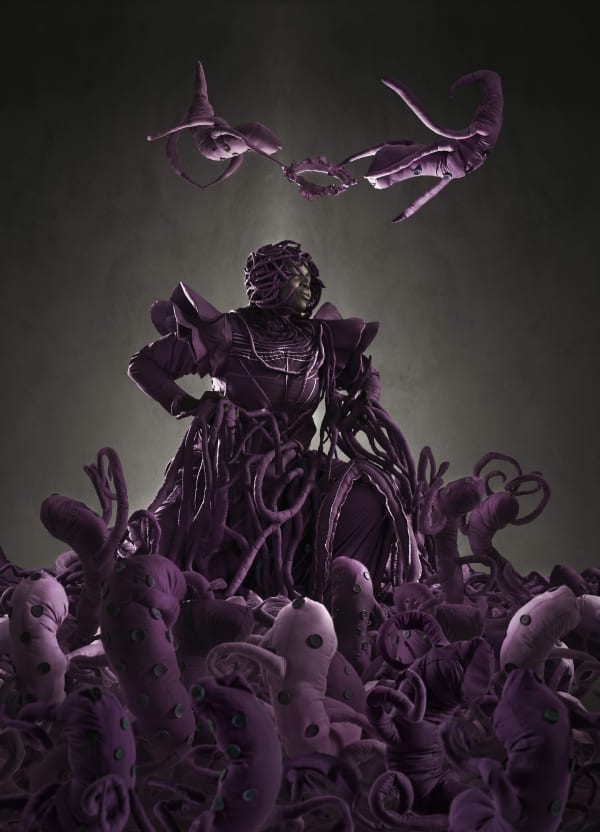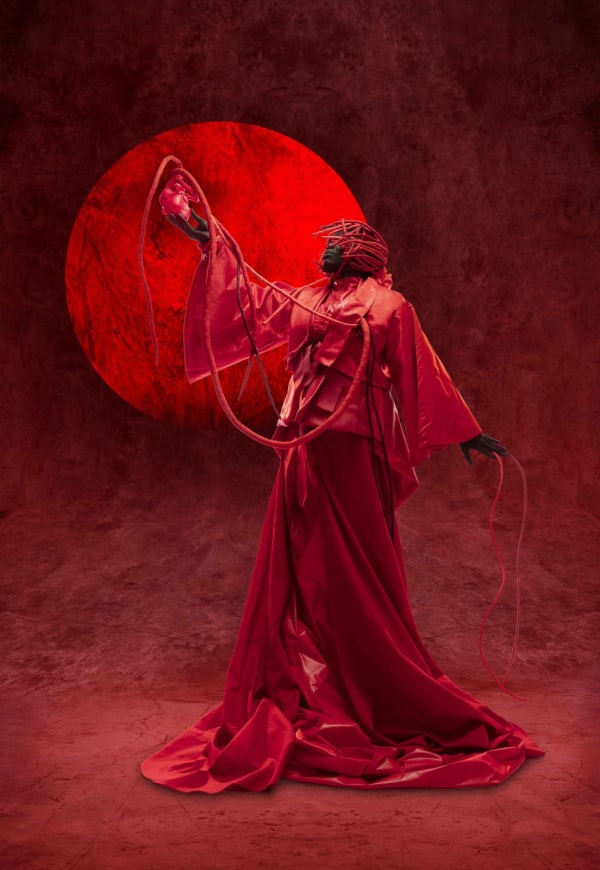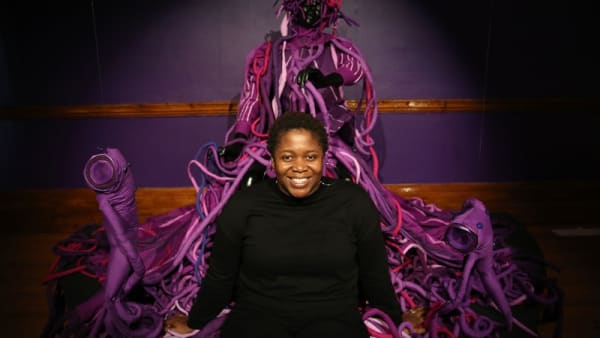Let me tell you about Red… is Mary Sibande’s first solo exhibition at the Durban Art Gallery. The exhibition takes place across three gallery spaces, with each gallery encapsulating the phases and periods of Sibande’s alter ego, Sophie, from her birth, to her expansion: following her evolution from 2009 to 2022. Sophie’s progression in character and representation is conjured up in the different worlds in which Sophie exists. “The first Sophie”, was created in 2009, thereby introducing the first persona of Sophie’s life to the world. Sophie makes her statement through the blue colour of her dress, a colour which seems to enliven her world and our understanding of her. Her symbolic narrative brings to the fore material, dress and objects which bring the grand narrative of life with the everyday, ubiquitous, Biblical, apocalyptic, transcendental, political and personal.
Through her own biographical reflections, Sibande articulates the complexities and multiplicity of Blackness and the Black women that bring forth the multi-dimensionality and hidden potential powers that yield an intangible world unbound by the reality of Sibande’s world. Using her own life as a mould for reflection through Sophie, Sibande has forged a new vision that allows us to dis-assemble, de-compose and reject the narratives imposed or set on Black bodies, particularly those of Black women. Through her colour periods of Blue, Purple and Red, we see Sophie take on the evolving phases of a Woman’s life; the birth and establishment of independence and agency, Motherhood and (perhaps) the clarity of emotional embodiment.
In the Purple - a transitional period - is a commentary on the ‘delayed’ freedom and equality that the 1994 election signalled as a promise to bring forth to Black people. There is a sense of the utopia being suspended.
Sophie, whilst inviting us to re-imagine the futures we want to see and live in. Sophie makes us experience time as “the nonexistence of the past, the not-yet of the future, the fleeting instant of the present” (David Scott, 2014). In this we see ‘Time’ no longer trapped in history, but occupying a new space of imagined reality, providing us a space to dream the impossible. Unlike the sculptural installation, the photographs of Sophie can be seen as episodic ‘Events’ which cannot be read within a linear chronological time frame. We are carried forward from event to event in an unstoppable stream.
Curated by Gcotyelwa Mashiqa
Blue Period: The birth of Sophie(s), 2008
The Sophies in this series are in celebration of her mother, grandmother, great grandmother and every Black woman who worked as a domestic worker due to the systemic opression of Black people and people of colour during apartheid South Africa. These renditions of Sophie are dressed in an adaptation of a domestic worker’s uniform, embellished, through a cinderella-like transformation, into a Victorian style inspired dress. Sibande transforming Sophie’s dresses is an attempt to assert honour, dignity and elegance to the stigma attached to the placement of black work, black life in industrial South Africa. This juxtaposition reflects on histories of servitude and demands a shift of perspective and visibility to its ongoing role in contemporary South Africa.
Purple Period: The Purple Shall Govern, 2014
In this series Sophie is evolving. She is taking control of each event she inhabits and is no longer a solo figure - she is now accompanied by vultures and wild dogs. Sophie is depicted in transition (going through pregnancy and eventually the journey to motherhood) - she is no longer in her domestic worker outfit. Her pose exudes confidence, and she looks content in her womb-like world surrounded by worm-like foetuses. In the works, A Terrible Beauty is Born (2013) and The admiration of the purple figure (2013) they are imbued with a sense of apprehension of the yet to be future….
Red Period, 2019
Is red the last phase in the evolution of Sophie? Even though we were slowly introduced the red narrative in moments, appearing as part of early Sophie’s dresses in the folds (Silent Symphony, 2010; Wielding the Collision of the Past, Present and Future, 2017) and as an accessory or ornament (Her Majesty, Queen Sophie, 2010). In the red period Sophie has transitioned into a (puppet) Master, ventriloquist or Priestess. In the photograph titled The Red Ventriloquist (2022) Sophie is depicted holding her heart up against the red full moon. Could this be the pose of victory – where all of Sophie’s emotions entrapped in the heart are relinquished, set free to be fully herself, to self-imagine/self-actualise?
Could the Red phase be about creating a space that acknowledges anger… particularly the anger of a Black woman? As bell hooks writes in ‘Killing Rage’ (1995) “My rage intensifies because I am not a victim. It burns in my psyche with an intensity that creates clarity. It is a constructive healing rage.”






